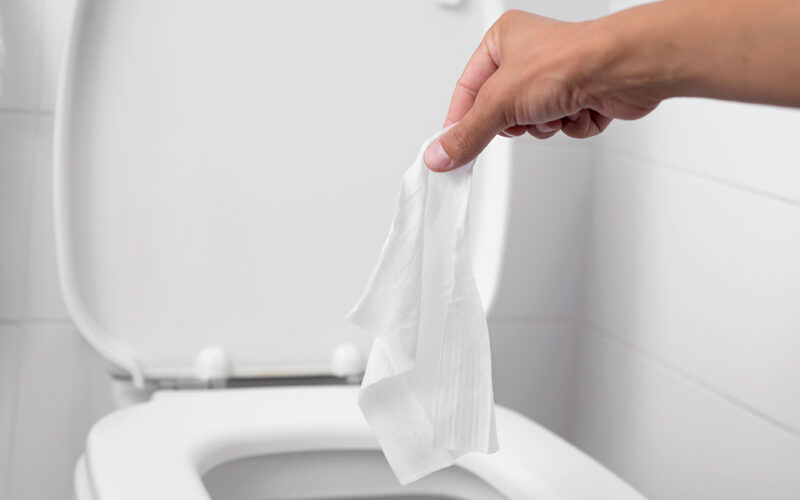A clogged sink, shower, tub, or toilet slows you down like nothing else. The initial step should always be to plunge or snake the toilet drain with a drain auger to clear it without damaging the pipes. However, if manual methods fail, the best toilet drain cleaners for your clog may be able to save you money on a plumber’s bill.
A chemical or enzyme-based toilet drain cleaner is efficient in de-gunking partially clogged drains, but they are ineffective for completely clogged drains. We’ve found the best toilet drain cleaner for each type of clogged drain, and our guide also contains instructions on how to use each one properly.
Types of Toilet Drain Cleaners
Enzymatic, caustic, and acidic liquid drain cleaners are all suitable for stubborn blockages in various drain sites and types of pipes and clogs. Some liquid toilet drain cleaners are meant to be used in conjunction with a drain snake to clear persistent grease obstructions in kitchen sinks.
Remove the drain cover (if present) and inspect the drain opening with a flashlight to detect the type of clog. Hair, paper, and other clogs at the aperture can be identified.
Make an educated assessment based on the clog’s location if the clog is deeper (kitchen sinks are magnets for food and grease, bathroom sinks and tubs often collect hair and soap scum, and toilets can accumulate paper products). Professionals may use a drain camera to inspect the photos produced by running it through the pipe to determine the type of clog.
Enzymatic
Enzymatic toilet drain cleaners contain bacteria that produce enzymes and feed on obstructions, such as bacillus. They’re meant to be used once a month to avoid clogs and can help clear clogs made of soft materials like hair or paper, but not tougher muck like oil or soap scum. Even a light blockage, however, can take up to 24 hours to remove. An enzymatic drain cleaner, on the other hand, is environmentally benign and excellent for clearing septic systems.
Newer and older plastic and metal drain pipes in sinks, showers, tubs and toilets are not corroded by their compositions, which are generally soft. They’re also usually free of dangerous pollutants and skin/eye irritants, so there’s no need for protective gear.
Caustic
Caustic drain cleaners use alkaline chemicals such as sodium hydroxide, which turn the clog into a soapy substance that dissolves in ordinary water. They’re best for cleaning food, grease, and soap scum from bathroom sinks, garbage disposals, showers, and tub drains in under 30 minutes, though most aren’t suited for use in toilets because they don’t handle paper items well.
Caustic cleaners are regarded as safe for plastic or metal pipes made of stainless steel or copper that are less than 20 years old. Avoid using them in plastic pipes older than 20 years (which can soften), older metal pipes, brass, aluminum chrome, or galvanized steel pipes of any age (which can tarnish or corrode).
They’re less harmful than acidic cleansers (and usually odorless), but contact or inhalation can burn the skin or irritate the eyes or nose, so use a respirator, safety glasses, skin-covering clothing, and gloves made of a chemical-resistant substance like butyl while handling.
Acidic
Sulfuric or hydrochloric acid is commonly used in acidic toilet drain cleaners. These drain cleaners are powerful enough to eliminate heavy-duty blockages in 15 minutes or less, such as hair, food, oil, soap scum, or paper-based jams. Acidic drain cleaners in the sink, tub, shower, and toilet drains are generally safe for newer plastic or metal pipes (e.g., copper).
They should not be used on ancient plastic or metal pipes, or pipes composed of aluminum chrome, stainless steel, or galvanized steel of any age. When breathed, they can burn skin and irritate eyes and lungs, so wearing protective gear such as a respirator, safety glasses, skin-covering clothing, and chemical-resistant gloves are essential.
Best Toilet Drain Cleaners of 2023
Our best picks were chosen for their overall quality and effectiveness. To assist buyers in finding the best drain cleaner, special attention was paid to the sorts of drain cleaners described above.
The Overall Best Toilet Drain Cleaner
Liquid Clog Remover Max Gel
Drano
At Amazon, $8
- Removes any blockages in standing water.
- It’s possible to leave it to work overnight.
- Clogs that are stubborn may require a second application.
This top performance is a popular choice among customers. Drano Max Gel is a thick gel that descends through standing water to the source of the clog and gets to work dissolving hair and melting soap scum, grease, and other gunky obstructions. It is safe for plumbing and septic systems. The gel takes 15 to 30 minutes to clear complete obstructions or slow-flowing drains. This approach can be applied a second time if the obstruction is persistent.
Best Single-Use Toilet Drain Cleaner
Green Gobbler
On Amazon, the Price Is $16.
- Doses that have been pre-measured
- Drains frequently require a second treatment that is applied overnight.
Green Gobbler’s single packets can make emptying a slow-flowing drain a breeze, with no measuring and no mess. Three pre-measured ready-to-use powder packets are included in each container; simply add water and wait 15-30 minutes before flushing (or wait overnight for tough clogs). While the packs themselves are odorless, some clogs may emit a foul stench as they break down – the scent will dissipate once the drain has been fully cleansed. Green Gobbler received a 4.3-star rating from over 9,000 Amazon reviewers, who praised how effectively it operated.
The Best Enzymatic Drain Cleaner
BIO-CLEAN
At Amazon, $50
- Aids in the cleaning of garbage disposals
- In toilets, it’s quite safe to use.
- Must be given at least eight hours to work (overnight)
- Complete clogs will not be cleared.
Bio-Clean breaks down organic waste like hair, grease, soap scum, paper, food particles, and more using a unique blend of naturally occurring bacteria and enzymes. It works more slowly than standard chemical drain cleaners since it is an enzymatic cleaner. This works best overnight on slow-flowing drains and as a once-a-month maintenance product. It won’t clear a complete blockage, and numerous applications may be required to clear partially clogged drains completely. Many reviewers attest to the efficiency of Bio-Clean as a preventative maintenance product. Bio-Clean is safe to use in toilets due to its composition.
Best Toilet Drain Cleaner for Monthly Build-up
CLR
Walmart: $10; Overstock: $23
- It’s also suitable for use in waste disposal.
- It does not remove all obstructions.
When it comes to drains, prevention is key, and CLR’s Clear Pipes and Drains make it simple to keep your pipes clear and avoid clogs with a monthly treatment. Testers praised how simple it was to use (it only takes five minutes!) and how clean their drains were afterward. Simply pour two ounces (four tablespoons) of the fragrance-free liquid down your drain overnight and flush with clean water the next morning. It’s also useful for clearing clogged drains.
Best Crystal Toilet Drain Cleaner
Thrift
At Amazon for $20
- Slow-draining sinks and tubs are cleaned.
- Maintains the septic tank system.
- It won’t clear clogs in standing water.
Thrift’s drain cleaner claims to work in 60 seconds on slow-flowing drains and is safe for septic system maintenance. Warm the pipes, dissolve and activate the crystals with hot water before flushing the drain fully after 60 seconds. The speed with which it functions has wowed reviewers. On grease traps, it can be left to work overnight. Thrift drain cleaner should not be used in garbage disposals or toilets because it is a strong chemical cleaner.
The Best Toilet Drain Cleaner With Chemical and Enzyme Combination
XIONLAB
At Amazon for $20
- Septic-system friendly
- Multiple treatments may be required for stubborn obstructions.
The XionLab Safer Drain Opener is septic-safe and works on hair or grease jams (but is not ideal for food particles). The gel will sink through standing water and eliminate moderate obstructions in roughly two hours, thanks to a balance of acidic/caustic cleansers and mild enzymatic cleaners (tougher clogs will take longer, sometimes overnight).
The Best Toilet Drain Auger for Clogged Toilets
RIDGID
Walmart: $71; Home Depot: 59
- The six-foot length reaches all the way down into the toilet pipes.
- To aid clear tough clogs, a drill can be added.
- The instructions are complicated and tough to follow for a beginner.
Where a plunger failed, a toilet auger may be able to help. When using a standard drain snake to clear a clogged toilet, the porcelain can be damaged, but the Ridgid incorporates a vinyl safety barrier that helps prevent scratches and cracks. The cable’s ergonomic handles make it simple to rotate it down the drain line to break up and eliminate obstructions.
Choosing the Best toilet Drain Cleaner for Clogged Toilets: A Buyer’s Guide
So, what does it take to be an excellent drain cleaner? In order to answer that question, we must consider the following factors.
How Does a Toilet Drain Cleaner Work
A toilet drain cleaner is usually a powder or solution containing chemicals that react with the clogging material and dissolve it. A toilet drain cleaner functions to clear obstructions via one or more of the following mechanisms, depending on the active chemicals in the product:
#1. Heat
Drain cleaners that are alkaline-based or caustic achieve their goal by raising the temperature of the area around the obstruction. The goal is to break down or melt the obstruction, allowing it to disperse. Ingredients like potassium hydroxide and lye are commonly found in them.
#2. Hydrolysis of Acid
Acid hydrolysis is a chemical reaction that occurs when certain acids are mixed with water. Acid hydrolysis produces a powerful molecule capable of dissolving almost everything. Nonetheless, because of the hazardous and caustic nature of these items, it is best to leave them in the hands of professionals.
#3. Oxidization
The process of oxidization includes forcing a substance to liberate electrons from its chemical structure, which causes it to break down at a fundamental level. Hypochlorites, nitrates, perchlorates, and peroxides are examples of highly oxidative substances that act on the material. This decreases the mass of the intrusive material, allowing it to disperse more easily.
#4. Action of Enzymes
Drain cleaners that utilize this method are the safest for you and the environment to use. Enzymes and microorganisms that devour organic matter are the active elements. Unfortunately, these drain cleaners will not work if the obstruction is caused by an inorganic substance.
Safety vs. Performance
It’s futile to use the most powerful drain cleaner to unclog your toilet if the consequences are damaged pipes and injury.
Take a look at the following examples:
Aluminum and old plumbing
Avoid acid- and alkaline-based drain cleaners if your plumbing is old and shows indications of corrosion since they will accelerate the corrosion. Instead, use enzyme-based products, which do not react with inorganic matter.
Complete Obstructions
Even the tiniest amount of drainage is impossible to achieve with a total obstruction. If you’re having trouble with your drains, avoid using acid or alkaline-based drain cleaners. This is due to the fact that they might become clogged and begin to corrode your pipes. To minimize excessive harm, the best remedy for total blockages is to have a professional inspect them.
Quantity of Product
It’s more cost-effective to buy a smaller quantity of a product if your system isn’t prone to clogging. If your toilet is prone to clogging, however, you would be better off purchasing a bigger quantity because buying in bulk saves money.
However, a drain-cleaning product should only be used as part of the whole remedy. If you’re having regular blockages, there’s a significant possibility there’s an underlying issue that has to be addressed. As a result, as you prepare for a professional inspection of your system, utilize the drain cleaner.
Safety
In the end, you don’t want to work with things that can injure you, especially if you’ll be using them on a frequent basis. Furthermore, it is critical to be aware of the environmental impact of your actions. Acid- and alkaline-based drain cleaners, as previously stated, can be hazardous to both you and the environment.
However, there are times when you simply must use them, such as when you need to cure a clogging problem quickly or when you discover that the obstruction is caused by an inorganic substance.
If this is the case, make sure you follow the required safety procedures. When using drain cleaners, for example, always wear heavy-duty gloves, an apron, and goggles. To avoid inhaling the harmful fumes from acid or alkaline-based cleansers, use a mask and open the windows.
However, the good news is that if you take these steps, you should have no need to be concerned.
Can You Put Drain Cleaner In A Toilet
Yes, drain cleaner can be used in a toilet. The issue you should be aware of is that using chemical drain cleaners will ruin your pipes as well as the clog you’re attempting to clear. If the clog isn’t too difficult to dissolve, a natural enzyme drain cleaning is preferable.
Toilet Drain Cleaner FAQs
How do you fix a slow draining toilet?
Pour half a cup of baking soda down the drain, then run a saucepan of boiling water over it. Allow it to sit for an hour or two before attempting to flush it again. This procedure has been reported to work successfully in unclogging sluggish draining toilets, albeit it may take a few tries.
What causes a toilet bowl to slow drain?
Low water in your tank, a clog in the toilet or a pipe coming out of it, or even a buildup of calcium and other hard minerals are all possible causes of a sluggish flushing toilet.
Does bleach unclog a toilet?
Bleach can help you unclog your toilet by breaking down clogs. It’s not as effective as a professional drain cleaner for clearing clogs, but it might work for tiny jams in a pinch. Pour around 2-3 cups of bleach into the toilet bowl and let it sink into the drainpipe to see for yourself.
What is the best drain cleaner for toilets?
Drano Max Gel is the best all-round drain cleaner since it works fast to remove stubborn obstructions. This dependable and powerful cleaner is a thick gel that penetrates sinks, pipes, and drains to reach the root of the clog and thoroughly dissolve it.






